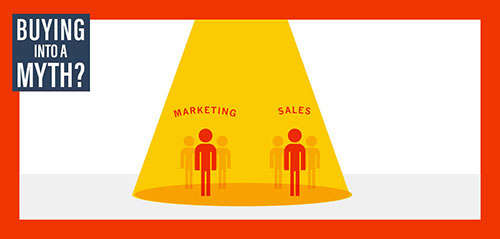BUYING INTO A MYTH?
Marketing Myth #7: Marketing is secondary to sales in B2B
It’s an age-old dynamic. In B2B, marketing generates the leads then hands them off to sales, which nurtures them and closes the deal. Sales sings the aria while marketing provides the accompaniment, out of the spotlight, on piano. At least that’s how it used to be.
What buyers want from sellers today
Today, B2B buyers are more savvy. They want to serve themselves during the purchase journey, so they’re taking the initiative and doing their own research online. Before a seller can even pitch them, they likely know all about the company and its products.
In a recent report, McKinsey asserts that “customers’ expectations of how their vendors serve them have changed dramatically – they want simpler, on-demand, omnichannel engagement that puts their needs first.”1
The demand-generation trap
Many B2B companies are struggling to adapt to this new dynamic and continue to focus on generating market-qualified leads. As McKinsey notes, this approach seeks to “push customers through a funnel to sellers without knowing whether those customers are ready to advance,” potentially annoying them in the process.
Seeing the limitations of this “sales-funnel” mentality, forward-thinking companies are shifting to a “customer buying journey” mindset instead. In fact, for the first time ever, B2B sellers are now more likely to offer e-commerce channels than in-person selling in the U.S.2
The rise of account-based marketing (ABM)
In line with this new focus on the customer journey, many companies are turning to ABM, where marketing and sales approach prioritized customers together. Instead of a singer (sales) backed by a piano player (marketing), the two now share the stage, working in unison.
What does this look like? In some companies, marketing and sales “collaborate in ‘pods’ that report to a combined business-unit leader… Marketers lead personalized content and self-serve digital tools, and train sellers to use these. They also educate sellers on their customer’s key buying factors and strategies to tailor content. Sellers then deliver the pitch and report back on how the content resonated.”
Last year, budget allocations for ABM eclipsed tools and technology, events and sponsorships, and marketing staff.
Survey of B2B marketing leaders4
Self-service tools make their mark
Beyond ABM, self-service tools are also taking hold. For example, all the major cloud providers – Amazon, Microsoft, Google, and IBM – offer prospects a customized visual business case for adopting their solutions.
With the embrace of self-service tools, sales are now being conducted without the seller, even at purchase. And B2B marketers, once limited to demand generation, are now actively involved in conversion. The takeaway? The self-serve journey is making every marketer a seller.
If you’d like to learn more about the emergence of marketing in closing the sale, let’s talk ›
1 McKinsey, “The future of B2B sales: The big reframe,” November 2022
2 McKinsey, “Busting the five biggest B2B e-commerce myths,” January 2022
3 McKinsey, “The multiplier effect: How B2B winners grow,” April 2023
4 Salesforce, “State of Marketing: 8th edition,” October 2022
Marketing Myth #1: Demand generation is king ›
Marketing Myth #2: Cutting marketing budgets is wise in a recession ›
Marketing Myth #3: Customer loyalty beats customer acquisition ›
Marketing Myth #4: Well-known brands don’t have awareness problems ›
Marketing Myth #5: B2B campaigns should be rational, not emotional ›
Marketing Myth #6: The purchase funnel is still a thing ›
Marketing Myth #8: Repeating what works will keep on working ›
Marketing Myth #9: Data-driven is always better than people-driven ›



 See what they have to say
See what they have to say